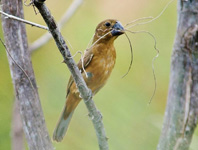Abstract
We describe a new spider species of the genus Agelenopsis Giebel 1869 (Agelenidae) from adult males and females. Agelenopsis riechertii is found in dry desert scrub habitats in the southwestern United States. While A. riechertii is similar to other sympatric congeners (A. aleenae, A. aperta, and A. spatula) in morphology and courtship behavior, it can be distinguished by an examination of its genitalia. Males possess an embolus that gradually narrows into a twisted tip which displays a convex edge from the lateral view. The female epigyna are harder to distinguish from congeners, but have a flatter anterior atrial edge that lacks strong bi-lobing. The spermatheca in female A. riechertii are also more elongate and comma-shaped than the other species. We describe the sequence of courtship behaviors exhibited by males, including the use of web pulses, abdomen waggling, and web flexing, in which males with fewer pauses, longer waggling bouts, and fewer web flexes are more likely to successfully copulate.
References
Ayoub, N.A., Riechert, S.E. & Small, R.L. (2005) Speciation history of the North American funnel web spiders, Agelenopsis (Araneae: Agelenidae): Phylogenetic inferences at the population—species interface. Molecular Phylogenetics and Evolution, 36 (1), 42–57.
https://doi.org/10.1016/j.ympev.2005.03.017Becker, E., Riechert, S. & Singer, F. (2005) Male induction of female quiescence/catalepsis during courtship in the spider, Agelenopsis aperta. Behaviour, 142 (1), 57–70.
https://doi.org/10.1163/1568539053627767Chamberlin, R.V. & Ivie, W. (1941) North American Agelenidae of the genera Agelenopsis, Calilena, Ritalena and Tortolena. Annals of the Entomological Society of America, 34 (3), 585–628.
https://doi.org/10.1093/aesa/34.3.585Galasso, A.B. (2012) Comparative analysis of courtship in Agelenopsis funnel-web spiders (Araneae, Agelenidae) with an emphasis on potential isolating mechanisms. Doctoral Dissertation. University of Tennessee, Knoxville, Tennessee, 251 pp.
Gering, R.L. (1953) Structure and function of the genitalia in some American agelenid spiders. Smithsonian Miscellaneous Collections, 121, 1–84.
Giebel, C.G. (1869) Über einige Spinnen aus Illinois. Zeitschrift für die gesammten Naturwissenschaft, 33, 248–253.
Hammerstein, P. & Riechert, S.E. (1988) Payoffs and strategies in territorial contests: ESS analyses of two ecotypes of the spider Agelenopsis aperta. Evolutionary Ecology, 2 (2), 115–138.
https://doi.org/10.1007/BF02067272Langenheim, J. (1996) Early History and Progress of Women Ecologists: Emphasis Upon Research Contributions. Annual Review of Ecology and Systematics, 27, 1–53.
https://doi.org/10.1146/annurev.ecolsys.27.1.1Maupin, J.L. & Riechert, S.E. (2001) Superfluous killing in spiders: a consequence of adaptation to food-limited environments? Behavioral Ecology, 12 (5), 569–576.
https://doi.org/10.1093/beheco/12.5.569Paison, T.C. (1997) A Biogeographic Review of the Spider Genus Agelenopsis (Araneae: Agelenidae). Master's Thesis. University of Tennessee, Knoxville, Tennessee, 123 pp.
Papke, M., Riechert, S.E. & Schulz, S. (2001) An Airborne Spider Pheromone Associated with Male Attraction and Release of Courtship. Animal Behaviour, 61, 1–11.
https://doi.org/10.1006/anbe.2000.1675Riechert, S.E. (1974) The Pattern of Local Web Distribution in a Desert Spider: Mechanisms and Seasonal Variation. Journal of Animal Ecology, 43 (3), 733–746.
https://doi.org/10.2307/3534Riechert, S.E. (1976) Web-Site Selection in the Desert Spider Agelenopsis aperta. Oikos, 27 (2), 311–315.
https://doi.org/10.2307/3543911Riechert, S.E. (1981) The Consequences of Being Territorial: Spiders, a Case Study. The American Naturalist, 117 (6), 871–892.
https://doi.org/10.1086/283776Riechert, S.E. (1985) Decisions in multiple goal contexts: habitat selection of the spider, Agelenopsis aperta (Gertsch). Ethology, 70 (1), 53–69.
https://doi.org/10.1111/j.1439-0310.1985.tb00500.xRiechert, S.E. (1993) Investigation of potential gene flow limitation of behavioral adaptation in an aridlands spider. Behavioral Ecology and Sociobiology, 32 (5), 355–363.
https://doi.org/10.1007/BF00183792Riechert, S.E. & Hedrick, A.V. (1993) A test for correlations among fitness-linked behavioural traits in the spider Agelenopsis aperta (Araneae, Agelenidae). Animal Behaviour, 46 (4), 669–675.
https://doi.org/10.1006/anbe.1993.1243Riechert, S., Reeder, W. & Allen, T. (1973) Patterns of Spider Distribution (Agelenopsis aperta (Gertsch)) in Desert Grassland and Recent Lava Bed Habitats, South-Central New Mexico. Journal of Animal Ecology, 42 (1), 19–35.
Singer, F., Riechert, S.E., Xu, H., Morris, A.W., Becker, E., Hale, J.A. & Noureddine, M.A. (2000) Analysis of courtship success in the funnel-web spider Agelenopsis aperta. Behaviour, 137 (1), 93–117.
https://doi.org/10.1163/156853900501890Smith, J.M. & Riechert, S.E. (1984) A conflicting-tendency model of spider agonistic behaviour: hybrid-pure population line comparisons. Animal Behaviour, 32 (2), 564–578.
https://doi.org/10.1016/S0003-3472(84)80294-8Whitman-Zai, J., Francis, M., Geick, M. & Cushing, P.E. (2015) Revision and morphological phylogenetic analysis of the funnel web spider genus Agelenopsis (Araneae: Agelenidae). The Journal of Arachnology, 43 (1), 1–25.
https://doi.org/10.1636/K14-35.1

